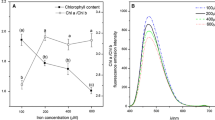Abstract
The physiological effects of lanthanum (III) ions on the ferritin-regulated antioxidant process were studied in wheat (Triticum aestivum L.) seedlings under polyethylene glycol (PEG) stress. Treatment with 0.1 mM La3+ resulted in increased levels of chlorophyll, carotenoid, proline, ascorbate, and reduced glutathione. The activities of superoxide dismutase, catalase, ascorbate peroxidase, monodehydroascorbate reductase, dehydroascorbate reductase, glutathione reductase, and peroxidase were also increased after La3+ treatment. Treatment with La3+ seems to enhance the capacity of the reactive oxygen species scavenging system, affect the Fe2+ and Fe3+ electron-transfer process in ferritin, and restrain the formation of hydroxyl radical (OH), alleviating the oxidative damage induced by PEG stress.
Similar content being viewed by others
References
J. F. Briat and S. Lobreaux, Iron transport and storage in plants, Trends Plant Sci. 2(5), 187–193 (1997).
J. P. Laulhere, A. M. Lescure, and J. F. Briat, Purification and characterization of ferritins from maize, pea and soyabean seeds. Distribution in various pea organs, J. Biol. Chem. 263, 10,289–10,294 (1988).
P. Aisen and I. Listowsky, Iron transport and storage proteins, Annu. Rev. Biochem. 49, 357–393 (1980).
A. H. Fitter and R. K. Hay, Environmental Physiology of Plants, Academic London (1989).
H. F. Bienfait, Prevention of stress in iron metabolisms of plants, Acta. Bot. Neerl. 38, 105–129 (1989).
X. X. Peng and M. Yamauchi, Ethylene production in rice bronzing leaves induced by ferrous iron, Plant Soil 149, 227–234 (1993).
J. F. Briat, Metal ion-activated oxidative stress and its control, in Oxidative Stress in Plants, D. Inzé and Van M. Montagu, eds., Taylor& Francis, London, pp 171–190 (2002).
D. A. Dalton, S. A. Russell, F. J. Hanus, G. A. Pascoe, and H. J. Evans, Enzymatic reactions of ascorbate and glutathione that prevent damage in soybean root nodules, Proc. Natl. Acad. Sci. (USA) 83, 3811–3815 (1986).
B. Halliwell and J. M. C. Gutteridge, Role of free radicals and catalytic metal ions in human disease: an overview, Methods Enzymol. 186, 1–85 (1990).
D. M. Miller and S. D. Aust, Studies of ascorbate-dependent, iron-catalyzed lipid peroxidation, Arch. Biochem. Biophys. 271, 113–119 (1989).
A. D. Dodge, Some mechanisms of herbicide action, Sci. Prog. (Oxford) 62, 447–466 (1975).
J. F. Briat, Roles of ferritin in plants, J. Plant Nutr. 19, 1331–1342 (1996).
J. P. Laulhere, A. M. Laboure, and J. F. Briat, Mechanism of the transition from plant ferritin to phytosiderin, J. Biol. Chem. 264, 3629–3635 (1989).
R. R. Crichton, Y. Ponce-Ortiz, M. H. J. Koch, R. Parfait, and H. B. Stuhrmann, Isolation and characterization of phytoferritin from pea (Pisum sativum) and lentil (Lens esculenta), Biochem. J. 171, 349–356 (1978).
A. Korcz and T. Twardowski, The effect of selected heavy metal ions on the in vitro translation system of wheat germ-protective function of plant ferritin, Acta Physiol. Plant 14, 185–190 (1992).
M. M. Bradford, A rapid and sensitive method for the quantitation of microgram quantities of protein utilizing the principle of protein-dye binding, Anal. Biochem. 72, 248–254 (1976).
C. N. Giannopolitis and S. K. Ries, Superoxide dismutase. I. Occurrence in higher plants, Plant Physiol. 59, 309–314 (1977).
R. F. Beers, Jr. and I. W. Sizer, A spectrophotometric method for measuring the breakdown of hydrogen peroxide by catalase, J. Biol. Chem. 195(1), 133–140 (1952).
Y. Nakano and K. Asada, Hydrogen peroxide is scavenged by ascorbate-specific peroxidase in spinach chloroplasts, Plant Cell Physiol. 22, 867–880 (1981).
M. A. Hossain, Y. Nakano, and K. Asada, Monodehydroascorbate reductase in spinach chloroplasts and its participation in regeneration of ascorbate for scavenging hydrogen peroxide, Plant Cell Physiol. 25, 385–395 (1984).
M. A. Hossain and K. Asada, Purification of dehydroascorbate reductase from spinach and its characterization as a thiol enzyme, Plant Cell Physiol. 25, 85–92 (1984).
M._Schaedle and J. A. Bassham, Chloroplast glutathione reductase, Plant Physiol. 59, 1011–1012 (1977).
R. Reuveni, M. Shimoni, Z. Karchi, and J. Kuc, Peroxidase activity as a biochemical marker for resistance of muskmelon (Cucumis melo) against Pseudoperonospora cubensis, Phytopathology 82, 749–753 (1992).
D. Arnon, Copper enzymes in isolated chloroplasts: polyphenol oxidase in Beta vulgaris, Plant Physiol. 24, 1–15 (1949).
N. Arakawa, K. Tsutsumi, N. G. Sanceda, T. Kurata, and C. Inagaki, A rapid and sensitive method for the determination of ascorbic acid using 4,7-diphenyl-1,10 phenanthroline, Agric. Biol. Chem. 45, 1289–1290 (1981).
S. Nakagawara and S. Sagisaka, Increase in enzyme activities related to ascorbate metabolism during cold acclimation of poplar twigs, Plant Cell Physiol. 25, 899–906 (1984).
A. Guri, Variation in glutathione and ascorbic acid content among selected cultivars of Phaseolus vulgaris prior to and after exposure to ozone, Can. J. Plant Sci. 63, 733–737 (1983).
R. L. Heath and L. Packer, Photoperoxidation in isolated chloroplast. I. Kinetics and stoichiometry of fatty acid peroxidation, Arch. Biochem. Biophys 125, 189–198 (1968).
L. S. Bates, R. P. Waldren, and I. D. Teare, Rapid determination of free proline for water-stress studies. Plant Soil 39, 205–207 (1973).
U. K. Laemmli, Cleage of structural proteins during the assembly of the head of bacteriophage T4, Nature 227, 680–685 (1970).
F. L. Zeng, Y. An, H. T. Zhang, and M. F. Zhang, The effects of La(III) on the peroxidation of membrane lipids in wheat seedling leaves under osmotic stress, Biol. Trace Element Res. 69(2), 141–150 (1999).
Author information
Authors and Affiliations
Rights and permissions
About this article
Cite this article
Zhang, L., Yang, T., Gao, Y. et al. Effect of lanthanum ions (La3+) on ferritin-regulated antioxidant process under PEG stress. Biol Trace Elem Res 113, 193–208 (2006). https://doi.org/10.1385/BTER:113:2:193
Received:
Revised:
Accepted:
Issue Date:
DOI: https://doi.org/10.1385/BTER:113:2:193




